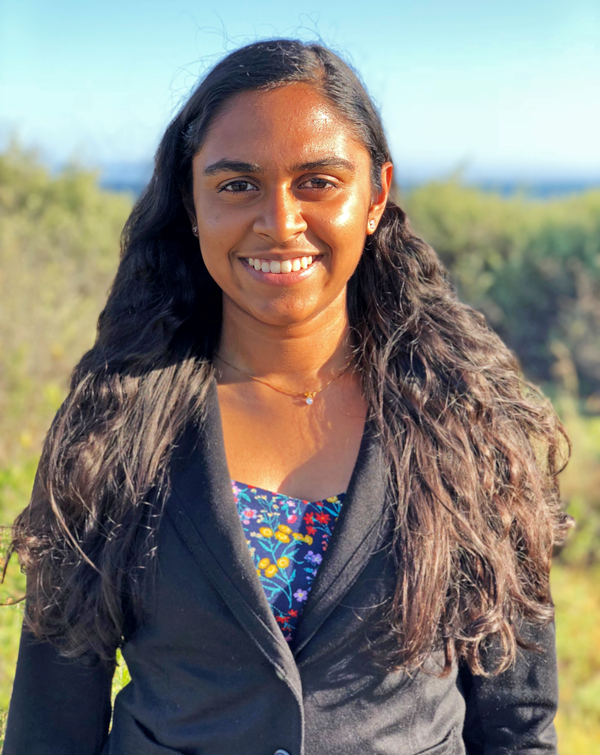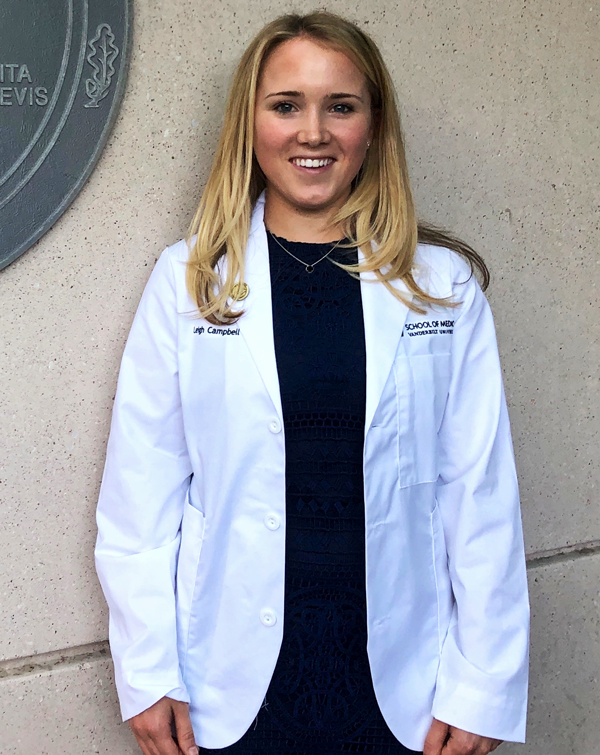VPIL Teamwork in the Time of COVID-19
by Emma Mattson
Not even a pandemic can stop interdisciplinary learning on VUSM’s campus.
Take the Vanderbilt Program in Interprofessional Learning (or VPIL, for short), for example. Each year, around 40 VUSM students join this unique learning community to spend one afternoon a week doing hands-on work in clinics across Nashville, collaborating with students from four other health-related professions.
This year, however, presented new challenges for the program. Incoming first-year students were entering clinic for the first time under unusual circumstances, while second-year students returned to the program with altered expectations and new safety guidelines.
We sat down virtually with four VPIL students to hear about their experiences on interprofessional teams during the past semester. Here’s what we found: though logistics and safety measures have changed, the radical interdisciplinary focus— and all the benefits that go along with that —remains the same.
Adapting to New Circumstances
When med students returned in person to VUSM’s campus this fall, they were met by a variety of new safety precautions and regulations. VPIL students, in particular, only interacted with COVID-negative patients at their respective clinics and wore appropriate PPE at all times.
 For Marshall Wallace, now in his second year of VPIL, COVID has meant seeing a slightly different group of patients. The walk-in clinic where his team works sees a lot of what he calls “bread-and-butter problems,” everything from arm rashes to abdominal pain. Normally, that list would also include influenza and mild respiratory problems, but, since those patients have a higher likelihood of having COVID, his VPIL team no longer interacts with them on a regular basis.
For Marshall Wallace, now in his second year of VPIL, COVID has meant seeing a slightly different group of patients. The walk-in clinic where his team works sees a lot of what he calls “bread-and-butter problems,” everything from arm rashes to abdominal pain. Normally, that list would also include influenza and mild respiratory problems, but, since those patients have a higher likelihood of having COVID, his VPIL team no longer interacts with them on a regular basis.
VPIL teams also stay socially distanced as much as possible, which means that team members interact with the patient in pairs or one-on-one, rather than as a whole team at once. That doesn’t mean their collaboration has diminished, however. If anything, the new challenges have only strengthened their communal resolve.
 M1 Alex Miller’s recent experience on a home visit exemplified this strength. Her team, which includes a nurse practitioner, a counseling student, and a pharmacy student, conducted a socially-distanced front porch visit to one of their patients at his place of residence. Their visit focused on brainstorming ways to improve his health through methods outside of prescription or referral.
M1 Alex Miller’s recent experience on a home visit exemplified this strength. Her team, which includes a nurse practitioner, a counseling student, and a pharmacy student, conducted a socially-distanced front porch visit to one of their patients at his place of residence. Their visit focused on brainstorming ways to improve his health through methods outside of prescription or referral.
On this visit, the diverse strengths of the team members really shone through, Miller said. They brainstormed with the patient on everything from better organizing his medications to reconnecting with his faith community.
“It’s awesome to be able to see how you can improve a patient’s life through all these different avenues and improve a patient’s overall health in a more holistic way,” Miller said. “I’ve really enjoyed that.”
An Interprofessional Perspective on Medicine
 Malini Anand, another first-year VPIL student, has known for years that interdisciplinary connections would be crucial for her medical perspective. In fact, back when she was a college student, she collaborated closely on an interdisciplinary team at a women’s free health clinic in her area. She even wrote about her interdisciplinary values in her med school personal statement, and when she heard about VPIL on her Vanderbilt interview day, she immediately knew she wanted to join the program.
Malini Anand, another first-year VPIL student, has known for years that interdisciplinary connections would be crucial for her medical perspective. In fact, back when she was a college student, she collaborated closely on an interdisciplinary team at a women’s free health clinic in her area. She even wrote about her interdisciplinary values in her med school personal statement, and when she heard about VPIL on her Vanderbilt interview day, she immediately knew she wanted to join the program.
“I knew that was something I definitely wanted more exposure to in medical school,” Anand said. “[VPIL] has only solidified how important interdisciplinary work is to me, because it just completely changes your perspective on how you even approach patient care.”
Now, Anand says, she thinks through more than the differential diagnoses: she also considers the patient’s emotional state, socioeconomic status, and potential barriers to making recommended changes in nutrition or medication.
Miller, too, highlighted the lessons that she learns from listening to her team members from varying professions.
“Each team member focuses on different aspects. For me, I get to practice the medical interviewing and the counseling student can focus on social determinants of health,” Miller said. “It’s really nice being able to hear and be part of other students’ conversations with the patient, because they’re so different from what I’ve been learning from the medical standpoint.”
Has the interprofessional experience changed her approach to medicine? Miller says, “Definitely.”
“It’s really highlighted the importance of not only being knowledgeable about the patient’s medical condition and how to fix that through medication or other medical intervention, but also the social determinants. How do we change behavior to increase medication compliance? What are the biggest barriers to this patient’s health?”
In fact, Miller said, understanding the patients’ felt needs from an interdisciplinary perspective builds an even stronger provider-patient relationship.
“When the patient sees that you’re aware of these other things that are going on, it instills more trust,” Miller said.
Taking on New Responsibilities
Acclimating to the interdisciplinary setting forms a crucial part of the first year in VPIL. After all, each student has to become acquainted with the clinic, their preceptor, the other team members, and the patient population they’ll be serving. For some students, VPIL is their first formal clinical experience. In short, there’s a lot to learn.
But after a year of clinical experience, second-year VPIL students are well-equipped to take on more clinical responsibilities and more difficult cases.
 “As an M2, we shift more into the clinical side of patient care rather than shadowing,” reports M2 Leigh Campbell. “In our clinic, we are also working on our VPIL quality improvement project.”
“As an M2, we shift more into the clinical side of patient care rather than shadowing,” reports M2 Leigh Campbell. “In our clinic, we are also working on our VPIL quality improvement project.”
Wallace, also an M2, notes that about this time last year his team was still figuring out how the clinic worked, what questions to ask, and how best to collaborate as a team.
Now, his preceptor has more confidence in the team’s ability, Wallace said. She often pairs the team members up to see the patients by themselves first, before regrouping to talk about patient care. This gives Wallace first-hand experience diagnosing many issues he’ll need to be proficient in as a future physician.
As for Campbell, taking on increased responsibility with her team has convinced her never to lose appreciation for the non-physician members of a healthcare team.
“Learning from my team and about their various curriculums in nursing, pharmacy, and social work showed me how integral each of them is in patient care. They all bring an individual skill set from their training,” Campbell said. “I have enjoyed getting to know them and building friendships that will last outside our time in VPIL together.”
Learn more about VPIL and how you can get involved at the VPIL website.
